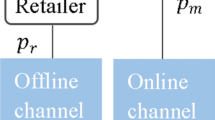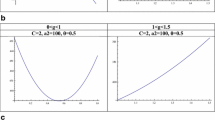Abstract
Manufacturers’ channel competition with service is examined in this paper. Specifically, the authors consider channel competition within a supply chain comprising two manufacturers and one single retailer where each manufacturer can choose to sell its products either directly to the end market (online channel, say) or through the potential retail channel, based on the profit maximization criterion, which is influenced by exogenous market conditions, such as the degree of competition, etc. Furthermore, the retailer provides additional demand-enhancing service to promote the manufacturer’sproducts distributed via it. If only one of the manufacturers sells products through the retailer, its products will be promoted by the additional retail service, which poaches demand of products of the manufacturer who adopts direct online channel. Products of both manufacturers are supported by the retailer’s promotional service when both distribute their product through the common retailer. Finally, some managerial implications are derived from numerical analyses of our model, which explain the phenomena in practice and conclude the paper.
Similar content being viewed by others
References (wenxian biaoti)
Rosen L D, Service: The next frontier, Hospital Materiel Management Quarterly, 1998, 19: 29–34.
HuWand Li Y, Retail service for mixed retail and E-tail channels, Annals of Operations Research, 2012, 192(1): 151–171.
Dorfman R B and Steiner P D, Optimal advertising and optimal quality, American Economic Review, 1954, 44: 826–836.
Levhari D and Peles Y, Market structure, quality, and durability, The Bell Journal of Economics and Management Science, 1973, 4: 235–248.
Spence A M, Monopoly, quality and regulation, Bell Journal of Economics, 1975, 6: 417–429.
Dixit A, Quality and quantity competition, Review of Economics Studies, 1979, 46:587–599.
Gal-Or E, Quality and quantity competition, The Bell Journal of Economics, 1983, 14(590): 590–600.
Jeuland A P and Shugan S M, Managing channel profits, Marketing Science, 1983, 2: 239–272.
Pasternack B, Optimal pricing and return policies for perishable commodities, Marketing Science, 1985, 4: 166–176.
Chen F, Information sharing and supply chain coordination, Handbooks in Operations Research and Management Science (eds. by Graves S C and de Kok T), Elsevier, USA, 2003, 341–421.
Cachon G P and Lariviere M A, Supply chain coordination with revenue sharing contracts: Strengths and limitations, Management Science, 2005, 51: 30–44.
Iyer G, Coordinating channels under price and non-price competition, Marketing Science, 1998, 17: 338–355.
So K C, Price and time competition for service delivery, Manufacturing & Service Operations Management, 2000, 2: 392–409.
Tsay A A and Agrawal N, Channel dynamics under price and service competition, Manufacturing & Service Operations Management, 2000, 4: 372–391.
Boyaci T and Gallego G, Supply chain coordination in a market with customer service competition, Production and Operations Management, 2004, 13: 3–22.
Bernstein F and Federgruen A, A general equilibrium model for industries with price and service competition, Operations Research, 2004, 52: 868–886.
Bernstein F and Federgruen A, Coordination mechanisms for supply chains under price and service competition, Manufacturing & Service Operations Management, 2007, 9: 242–262.
Xia Y and Gilbert S M, Strategic interactions between channel structure and demand enhancing services, European Journal of Operational Research, 2007, 181: 252–265.
Gilbert S M, Yu G, and Xia Y, The strategic effects of a merger upon supplier interactions, Naval Research Logistics, 2007, 54: 162–175.
Chen K Y, Kaya M, and Ozer O, Dual sales channel management with service competition, Manufacturing & Service Operations Management, 2008, 10: 654–675.
Kurata H and Nam S H, After-sales service competition in a supply chain: Optimization of customer satisfaction level or profit or both?, International Journal of Production Economics, 2010, 127: 136–146.
Corbett J C and Karmarkar U, Competition and structure in serial supply chains with deterministic demand, Management Science, 2001, 47: 966–978.
Cattani K, Gilland W, and Swaminathan J M, Coordinating Internet and traditional supply chains, Handbook of Quantitative Supply Chain Analysis: Modeling in the E-Business Era (eds. by Simchi-Levi D, Wu D, and Shen M), Kluwer, USA, 2004, 643–677.
Rhee B and Park S Y, Online stores as a new direct channel and emerging hybrid channel system, Working Paper, Hong Kong University of Science and Technology, 2000.
Chiang W K, Chhajed D, and Hess J D, Direct marketing, indirect profits: A strategic analysis of dual-channel supply chain design, Management Science, 2003, 49: 1–20.
Cattani K, Gilland W, Heese H S, and Swaminathan J, Boiling frogs: Pricing strategies for a manufacturer adding a direct channel that competes with the traditional channel, Production and Operations Management, 2006, 15: 40–56.
Huang W and Swaminathan J M, Introduction of a second channel: Implications for pricing and profits, European Journal of Operational Research, 2009, 194: 258–279.
Cai G, Channel selection and coordination in dual-channel supply chains, Journal of Retailing, 2010, 86: 22–36.
Khouja M, Park S, and Cai G, Channel selection and pricing in the presence of retail-captive consumers, International Journal of Production Economics, 2010, 125(: 84–95.
McGuire TW and Staelin R, An industry equilibrium analysis of downstream vertical integration, Marketing Science, 1983, 2: 161–191.
Anderson E J and Bao Y, Price competition with integrated and decentralized supply chains, European Journal of Operational Research, 2010, 200: 227–234..
Xiao T and Yang D, Price and service competition of supply chains with risk-averse retailers under demand uncertainty, International Journal of Production Economics, 2008, 114: 197–200.
Yang D, Xiao T, and Shen H, Pricing, service level and lot size decisions of a supply chain with risk averse retailers: Implications to practitioners, Production Planning & Control, 2009, 20: 320–331.
Author information
Authors and Affiliations
Additional information
This research is partially supported by the National Science Foundation of China under Grant No. 71090401/71090400.
This paper was recommended for publication by Editor WANG Shouyang.
Rights and permissions
About this article
Cite this article
Bian, J., Lai, K.K. & Hua, Z. Manufacturers’ channel competition with retailer demand-enhancing service. J Syst Sci Complex 28, 887–906 (2015). https://doi.org/10.1007/s11424-015-2123-7
Received:
Revised:
Published:
Issue Date:
DOI: https://doi.org/10.1007/s11424-015-2123-7




